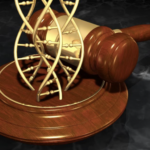A History of the Codification of Law and the Separation of Powers

Laws and legal systems are meant to be the framework by which moral standards and social order are maintained, with the utilitarian objective of benefiting a social group as a whole; whether that be a tribe, community, a nation-state and its separate jurisdictions or, in the case of international law, humans across the globe.
Without laws, whether written or understood through custom, social groups are at risk of degenerating into ‘anarchy’ and the potentially self-serving, opportunistic, harmful and dangerous acts that can go with it – conduct which may satisfy the desires of one party while grievously harming another or others.
Incidentally, the word anarchy is derived from the Greek word anarchos, meaning without a leader; a state often seen as the antithesis of law and order, and synonymous with an undesirable and dangerous state of disarray.
The first recorded use of the English word anarchy was in 1539, and denoted absence of government. Its connotation today has broadened to encompass various states of disorder and confusion.
Origins of written law
Although seen as piecemeal and often inconsistent and even contradictory, records exist of rules recorded by Egyptian pharaohs dating as far back as 5,000 years.
The first such laws are believed to have been formally set down and developed under the Egyptian King Menes, in approximately 3000 BC, with crime and punishment based on religious virtues and principles of morality.
Codified laws
The Code of Hammurabi, named after the King of Babylon, who reigned from 1792 to 1758 BC and according to legend was given the laws by the God of justice known as Shamash, is credited with the documentation of such law for posterity.
The legal text was apparently composed and written in the ancient Babylon dialect of Akkadian by the King himself.
Carving the laws on stone or marble and appointing judges to ensure obeyance of them, they were distributed throughout prominent areas, in the Kingdom of Babylon.
A main copy was inscribed on a basalt stele, which can be seen at the Louvre museum in Paris.
Whilst this was regarded as the first recorded written code, the actual first law codes were claimed to have been formulated between 2100 & 2050 BCE by the ancient Sumerian King Ur-Nammu.
King Ur-Nammu appeared to allow his people to believe the laws came from the gods, the moon god, Nanna in particular, as his thinking was that people were less likely to offend against the gods. A king with psychological skills.
The ancient Kingdom of Sumer was located in the southern part of what is now known as Iraq and which the Greeks later called Mesopotamia.
Roman law in 450 BC is regarded as the most detailed legal code of ancient times, with trials determined by a jury of 32 men and was named the Latin Lex XII Tabularum (law of the twelve tables)
Sadly, discrimination had not yet been addressed within society.
No win no fee was once simply, no fee at all
Around 204 BC, a law prevented Roman lawyers from charging a fee for representing a client, normally a friend or a person referred through an acquaintance. That’s not to say this law precluded a fee being paid by virtue of an annuity or such similar method.
However, Emperor Claudius approved legal advocacy as a profession and permitted a fee to be formally charged, albeit with a limit of 10,000 sesterces. (equivalent to a usd 0.50 amongst other confusing calculations in today’s money)
This, indeed, would have been a considerable fee in those times one would have thought, contrary to it not being considered as such?
Law in the United States
The United States constitution, written in 1787, ratified in 1788 and effected in 1789, bestows on American courts, the responsibility to interpret the meanings of the constitution, in addition to laws passed by the US Congress, as it codifies the core values of US society.
Any conflict between the constitution and laws passed by congress, is preferenced by the constitution.
It took quite a while for lawyers to be accepted in the colonies of the Americas, some colonies actually outlawing lawyers. However, once the colonies began thriving, the need for lawyers became evident and law bars were established to ensure that lawyers followed professional ethics, as indeed did a variety of law schools, colleges and universities in time.
Soon followed respect for the legal profession and in 1793, four years after the constitution, the first law degree was a bachelor of law called an L.B. issued by the college of William and Mary and later to be referred to as an LLB (bachelor of laws), then juris doctor (J.D.) (Doctor of jurisprudence) in the 1960s, the first one being awarded by Harvard university. Though, there is a difference.
This though, has been contested in certain circles, who maintain that the first independent law school established in the US was the Litchfield law school in Connecticut, founded by lawyer, Tapping Reeve, who commenced teaching his first law student in 1774; leading many law historians to suggest that the first law degree would have been awarded earlier than that from the college of William and Mary.
How does law operate in the US?
In essence, congress creates and passes the bills, with the president of the US determining which will be signed into law, upon which they will be reviewed by federal courts to check they are compliant with the American constitution.
If a law is determined to be unconstitutional, it will be struck out by the courts.
Congress contains two legislative chambers, the US senate and the US house of representatives and members of either may propose a new law.
The Separation of Powers
In simple terms, the doctrine of the separation of powers stipulates that a society’s main institutions, the legislature, executive and judiciary be divided, was in order to ensure checks and balances, which avoid any aspect of autocracy.
Essentially, the legislature makes the laws, the executive ensures that the laws are implemented and operate and the interpretation of those laws are the sole domain of the judiciary.
The function of each branch whilst interdependent on each other, exercise separate functions and powers, thereby avoiding certain past monarchies and all dictatorships in relation to the issue of what is known as absolutism.
Absolutism can be seen as a form of autocracy
Separation of powers – US style:
The doctrine of the separation of powers was incorporated within the United States constitution, in order to prevent a division of the government, or a person becoming too powerful. Essentially, each division, namely the legislature, executive and judiciary should be completely independent and keep an eye on each other, by way of checks and balances.
One of the US founding fathers, James Madison said at the time of framing the constitution, that the truth is that all men having power ought to be mistrusted.
It was believed that with the three primary branches of the government working independently, this was the reason that liberty would be maintained.
Such was how well this concept was accepted, the vast majority of US states inserted similar formats in legislation for their own governments to follow.
Naturally, such a simple enough concept that promotes independence, equality and fairness, in addition to preventing corruption, should be straightforward enough to implement!
Not on your life, as the saying goes.
How can it be straightforward when you have the president of the United States of America, amongst other things, able to:
- Issue executive orders,
- Declare local and national emergencies,
- Grant and revoke security classifications,
- Grant presidential pardons for federal crimes, and
- Withhold information from congress through executive privilege.
Most famous American lawyer
This lawyer passed the bar in Springfield, Illinois in 1836, representing clients in both criminal and civil cases.
He became a politician and then the 16th President of the United States of America in 1861, until his assassination in 1865.
His name was Abraham Lincoln.
Great Britain’s step forward in its evolution of law
The Law Terms Act of 1830 saw the first evolutionary alteration to the 300-year-old system of the assize courts, with Chester and the Welsh counties brought into the general circuit and the court of great sessions abolished.
Soon, the Old Bailey would exist, dispensing justice throughout London and its suburbs.
1846 saw the various county courts amalgamated to form one single court, under the County Courts Act and 10 years later, the Old Bailey was approved to hear any cases to ensure local prejudice didn’t unfairly impact on a trial.
The unification of the common law and equity courts, including the court of Chancery enabled all courts to administer equity and common law, bearing in mind that a division of the High court still came under the Chancery division; by virtue of the enactment of the Judicature Act 1873.
What we know as crown courts, were formed in 1956, initially in Manchester and Liverpool and dealt with the quarter sessions matters in those cities.
The Courts Act 1971, created in response to the Royal Commission on Assizes and quarter sessions from 1966 to 1969 resulted in the formation of a unified crown court and the abolishment of the courts of assize and quarter sessions.
The UK version of the separation of powers
Many hundreds of years of evolution may have seen a more independent judiciary, however until 2006 the Lord Chancellor was still involved with the judiciary and government.
The Constitutional Reform Act 2005 was meant to change all that, with it being hailed as the most significant change to law, since the Magna Carta; supposedly, ensuring the separation of powers was just that.
Although, when Magna Carta Libertatum, otherwise known simply as the Magna Carta was proclaimed in 1215, being the initial precursor to a quasi-form of the separation of powers, that should have been enough, as it clarified that King John and his government were not above the law.
However, it wasn’t ever going to be plain sailing, as soon after, King John asked pope Innocent III to annul the Magna Carta, creating a war called the first barons war, between the English barons and the monarchy, which lasted for 2 years.
King John must have thought that this separation of powers idea was not going to work for him.
1,000 years of its existence and the British judiciary claimed that it officially had a fully independent and equal branch of the State, with absolutely no connection to the government. Not so!
It was also claimed that the independence of the judiciary was fully protected by the Constitutional Reform Act of 2005, which replaced the Lord Chancellor with the Lord Chief Justice as President of the courts and head of the judiciary. However, this was simply not true.
Prior to this, the Lord Chancellor was part of both the government and the judiciary, similar to previous Lord Chancellors, ensuring the ever-present conflict of serving two masters existed.
However, it appears that the Lord Chief Justice today, shares responsibility with the Lord Chancellor for the office for judicial conduct investigations, which looks into complaints against judicial office holders.
Not only that, but one of the Lord chancellors other duties involve judicial policy and remunerations.
Dominic Raab who was appointed Lord Chancellor and secretary of state for justice in October 2022 and as such, is obviously connected to the government, being the deputy prime minister, is a prime example of what has just been discussed.
It is one thing to say that the Lord Chancellor’s office has a separate cadre of civil servants, independent of government, but it defeats the purpose if the boss is not independent of government and the judiciary and the absolute truth of the matter is that Dominic Raab simply is not.
It is clear that the deputy prime minister also has an association with the judiciary, even if it is suggested it is at arm’s length.
Lord chancellor, referred to at times as Lord high chancellor or Lord keeper of the great seal, which was affixed as the sovereign signature on state documents, etc., is only the custodian for England.
Scotland, Northern Ireland and Wales have their own custodians of those countries great seals.
Australia’s evolving law
With colonisation of Australia by the British, came the UK brand of law, with the Australian constitution in 1901, ensuring that Australia, initially made up of six colonies, New South Wales, Queensland, South Australia, Tasmania, Victoria and Western Australia, had the beginning of an independent Australian legal system.
Since federation, Australians have two broad legal systems to contend with, one being federal and the other of the state in which they reside or were passing through when a legal matter arose.
Pre-colonisation, Australia’s law consisted of a number of systems of customary Indigenous law, dependent on regions, clans and dialect and interconnected by way of song, stories and dance intergenerationally.
Here’s a short chronology of changes to the Australian constitution:
- 1906 -senate elections – amended section 13 to slightly alter the length and dates of senators terms of office.
- 1910 – state debts – amended section 105 to extend the power of the commonwealth to take over pre-existing state debts, to debts incurred by a state at any time.
- 1928 – state debts – inserted section 105A to ensure that constitutional validity of the financial agreement reached between the commonwealth and state governments in 1927.
- 1946 – social services – inserted section 51 (xxvi) to extend the powers of the commonwealth to Indigenous Australians in states; repealed section 127 preventing the inclusion of all Indigenous Australians in population counts for constitutional purposes.
- 1977 – three amendments: First to ensure senate casual vacancies be filled by a member of the same political party; second to allow residents of Australian territories to vote in referendums; third to mandate for a retirement age of 70 for judges in federal courts.
The Australia Act
The Australia Act 1986 (Cth) was enacted at the same time an similar UK Act to bring constitutional arrangements into conformity with the status of the Commonwealth of Australia as a sovereign, independent and federal nation.
This Act, including the six passed by the state parliaments, essentially made Australian law independent of the British parliaments and its legal system.
Whilst the Statute of Westminster Adoption Act 1942 gave Australia autonomy of sorts, the Australia Act eradicated the remaining British legal authority at federal level, though Queensland continued to utilise the British court system until 1988.
1986 was a good year for Australian legislation, with the enactment of the Australian human rights commission Act 1986.
However, whilst this was a progressive, but small step in the arena of human rights, the Australia Act was a gigantic leap for Australians, not only in removing the UK parliament from making Australian laws and eradicating the right of appeal from Aussie courts; but by acquiring complete and independent control of Australian constitutional documentation.
High court of Australia in 1992, declared the once legal concept of Australia being terra nullius to be invalid. A just and emotional judgment for all first nations people.
Enacting laws in Australia
About half of a member of the parliament’s time is said to be accounted for by listening, then debating and voting on proposed new laws or amendments to existing laws, or even repealing laws.
Proposed laws are called bills of parliament, and under the Australian constitution, proposing new commonwealth laws and amending and repealing of existing ones can only be achieved by or in accordance with an Act of parliament.
That, by the way, may only be done in relation to specific matters, including:
- International and interstate trade,
- Foreign affairs,
- Australian defence forces,
- Immigration,
- Taxation,
- Banking,
- Insurance,
- Marriage and divorce,
- Currency, weights and measures,
- Australia post and telecommunications, and
- Invalid and old age pensions.
Australian states still hold control in many other aspects, including:
- Local government,
- Infrastructure including roads,
- Health including hospitals, and
- Education including schools.
Both commonwealth and the states both legislate in relation to criminal matters, with the commonwealth under what is called express incidental power in section 51 (xxxix) of the constitution, or in implied powers in sections 51 & 52, including section 61 regarding executive power.
Further expansion by the commonwealth in relation to legislating criminal matters, has been when the states believe a commonwealth law is more appropriate than the state or territory one, deferring to the commonwealth.
Examples of occasions whereby this has occurred, include anti-terrorism legislation and corporations regulation.
So, from only prosecuting or legislating in relation to crimes against the commonwealth, it covers many other areas of national concern today.
Incidentally, there have been many Acts given royal assent, which have benefitted Australians from all walks of life and enhanced law in Australia, the specifics of which will form part of a SCL series in the near future.
Australia’s brand of the separation of powers
Adopting the Westminster system from the United Kingdom, there is substantial interconnection between two branches in particular, that of the legislature and the executive; meaning that the separation of powers cannot operate as it is meant to in its entirety.
The reason is partly as a result of the fact that the legislature exists in the form of parliament and the executive in the form of ministers who are responsible to parliament.
Put simply, many believe there is too much of an overlap between the different arms, for reasons including:
- Parliament, which makes and amends the law and is referred to as the legislature, is made up of the King who is represented by the Governor-general, the senate and the house of representatives.
- Executive, which puts the law into action, is made up of the King, prime minister and other ministers.
- Judiciary, which is made up of the High court of Australia and other federal courts.
Here’s the catch though!
- The prime minister and ministers are part of the executive and parliament.
- High court judges, the prime minister (in the most unusual and extraordinary circumstances) and ministers are officially appointed by the Governor-general, who is part of parliament and the executive.
- The Governor-General is appointed by the King on the advice of the prime minister.
However, the Australian judiciary maintain a strong degree of independence, partly based on the constitutional guarantees of tenure and remuneration.
Political scientists
It is clear that all democratic countries, by ascribing to the separation of powers doctrine, will engender a more transparent and just society, even although there exists no country able or indeed willing to follow that doctrine to the letter of the law.
This is due to governmental powers being so complex and interrelated to enable them to be simply compartmentalised, which results in some hiccups along the way.
By the same token, however, no country can truly call itself democratic, if it doesn’t have some form of a separation of powers legislation.
Whilst some political scientists say the theory is wonderful but maintain that the separation of powers is not actually practised, this is not correct.
It is simply not practised in the manner expected by French philosopher, Charles-Louis de Secondat, Baron de La Brede et de Montesquieu, who wrote about it in 1748, although some political historians claim that its origin can be traced to Aristotle and Plato amongst others who claim a stake in the original concept.
Aristotle and Plato, philosophers who specialised in politics, science and ethics, were both Greek.
Whilst not practised in its entirety in every country which has adopted a version of it, its saving grace is that it permits an avenue to challenge the decisions of the legislature and the executive through the practically independent judiciary.
A further primary safeguard is that any such challenge will be subject to vast media exposure, ensuring that the matter is examined and, in many instances, dealt with in an appropriate way.






